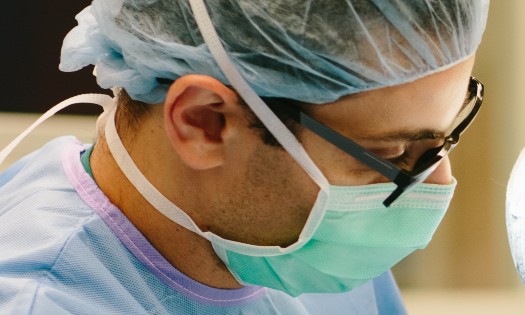Shortly after birth, a baby girl was diagnosed with type C esophageal atresia at a hospital near her Texas home. There, surgeons repaired her esophagus and closed off her fistula (an abnormal connection between the esophagus and trachea). But after the procedure, she was unable to feed and had dangerously low oxygen levels. That’s when she was put on long-term ventilation and transferred to the Level IV NICU at Children’s Health℠ in Dallas.
Our multidisciplinary team evaluated the patient and determined that she had severe tracheomalacia, a condition that occurs in about 15% of esophageal atresia patients.
Her case was particularly complex. The aorta was compressing the trachea and she needed an aortopexy to relieve this.
“Most surgeons would choose to make a relatively large incision in the chest to work in this high-stakes region,” says Samir Pandya, M.D., Pediatric General and Thoracic Surgeon at Children’s Health and Associate Professor of Surgery at UT Southwestern. “While this is not wrong, we were confident in our program's ability to use a minimally invasive approach that would be safe, effective and successful. This would afford her the opportunity to have less pain and recover faster without a visible scar.”
Multidisciplinary Evaluation
Upon arrival at the neonatal intensive care unit at Children’s Health, the team suspected tracheomalacia secondary to two possible sources of the tracheal compression: the proximal pouch or the aorta.
A multidisciplinary team consisting of pediatric surgeons, otolaryngologist, gastroenterologists, radiologists and neonatologists conducted a comprehensive, systematic evaluation to confirm the diagnosis.
“Among other studies, we obtained a dynamic CT scan to get as much information about the airway compression at the different phases of respiration,” Dr. Pandya says. “We also performed a bronchoscopy to get a real-time direct visual airway evaluation.”
Both studies demonstrated a collapsed upper airway, confirming tracheomalacia secondary to aortic compression.
“By cross-referencing the CT scan and bronchoscopy images, we identified the exact point of compression and the cause – the aorta,” says Dr. Pandya.
Together, the team decided thoracoscopic aortopexy was the best course of action to effectively treat the condition with the fewest potential side effects.
A Minimally Invasive Alternative to Major Open Surgery
Designated as a Level I Children’s Surgery Center by the American College of Surgeons, our pediatric general and thoracic surgeons treat more patients with minimally invasive procedures than any other hospital in the region. The team is comprised of several world-renowned experts in pediatric surgery. The vast institutional experience allows them to care for the most complex patients, of all ages, with relative ease.
“If we would have done this surgery open, we would have made a three to four inch incision along the chest wall,” he says. “Because of our team’s experience with minimally invasive procedures, we’re able to sew in this small space with just a few incisions that are five millimeters or less.”
This patient’s procedure involved suspending the aorta to relieve the tracheal compression.
“We used thoracoscopic guidance to find the area compressing on the trachea,” Dr. Pandya says. “Then we put stitches through the sternum into the aorta and back up through the sternum, thereby suspending the aorta like a hitch.”
In the two-hour procedure, they relieved the blockage. Subsequently, the baby was able to breathe on her own without experiencing the frequent and long periods of oxygen desaturation that she had previously.
After a few weeks of neonatal care, she went home for the very first time. She briefly had a feeding tube and was soon able to eat entirely by mouth.
Lifelong Benefits Beyond Smaller Scars
For this baby and patients like her, the benefits of minimally invasive pediatric surgery go beyond cosmetic.
“Babies who undergo minimally invasive techniques tend to recover faster, have less pain and have an excellent short and long-term cosmetic result,” Dr. Pandya says. “They also typically go home faster because they’re able to feed quicker and they don’t have big wounds that are in jeopardy of infection.”
This minimally invasive surgery also leads to better long-term outcomes than the open surgery alternative.
“When babies have an open surgery with an incision along the chest wall, they can develop musculoskeletal defects, such as scoliosis,” Dr. Pandya explains. “Some studies have shown that can occur in about 40% of kids who have a thoracotomy as a baby.”
Comprehensive Follow-Up Treatment
Babies with esophageal atresia need ongoing screening for complications following surgery. It’s not uncommon for these patients to have a stricture, leaking or recurrence of the tracheoesophageal fistula. Our pediatric surgeons and gastroenterologists work together to evaluate these patients and select appropriate treatment.
For example, we detected that this baby also developed a stricture, or a narrowing of the esophagus at the connection point.
“Our world renowned interventional gastroenterologists used a minimally invasive procedure with special balloons to dilate out the stricture without any resulting scar or reoperation,” Dr. Pandya says.
Effectively Treating the Most Complex Surgical Cases
This patient is now a happy, healthy 2-year-old who enjoys playing outside. Her story is just one example of how we’re using minimally invasive surgery in even the most complex cases to help patients achieve healthier futures.
"We’re able to achieve excellent outcomes in part because our team is constantly looking for ways to make surgery less invasive and more effective," Dr. Pandya says. “Health care is a team sport. Contributions from the nurses, OR staff, dietitians and child life specialists are just as important as those from the physicians if not more so in many cases. Together we make this a very special place where kids and parents know they're getting the best possible care.”
Learn more about the innovative surgical care at Children's Health >>


